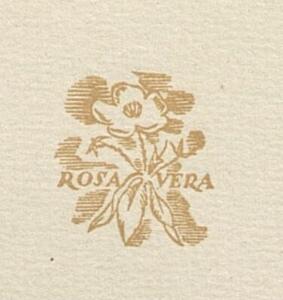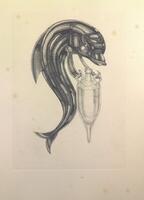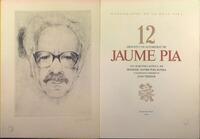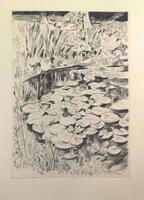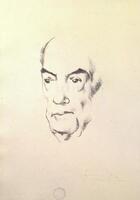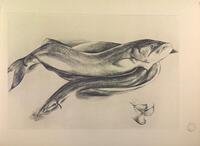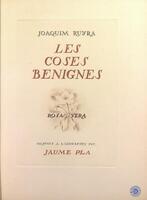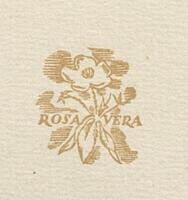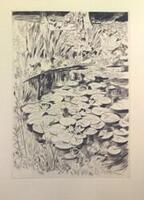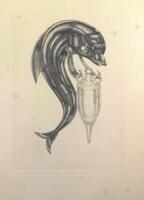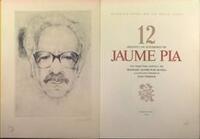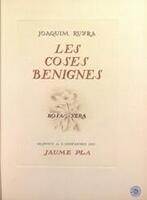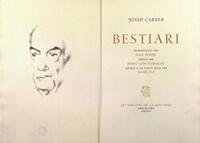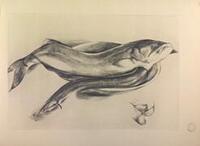Edicions de la Rosa Vera
(Updated 08/10/2024)
Jaume Pla created the Rosa Vera publishing house in 1949, with the economic backing of Víctor M. d’Imbert, even though prior to that date five illustrated books with the Rosa Vera imprint had already been published, the first in 1945. In line with the founder’s ideology, the publishing house is characterised by the importance it attached to illustration.
+ informationSearch collections
Edicions de la Rosa Vera collection at the Biblioteca de Catalunya
The documentation from this publishing house is in the Ramón Borràs collection of autographs. Several documents are conserved, including letters, receipts and contracts which span from 1945 to 1975. The set of publishing catalogues from the Bergnes de las Casas collection contains some of its catalogues.
Catalogue of publishers from the Bergnes de las Casas collection (Biblioteca de Catalunya)
More information and documentation on the works produced
Els 98 gravadors de la Rosa Vera : del 6 de febrer al 7 d'abril de 1985, Palau de la Virreina. Barcelona: Ajuntament de Barcelona, DL 1984.
Rosa Vera: una aportació a la història del gravat modern a Catalunya, tesi doctoral de Maria Mercè Casanovas i Aleix.
Edicions de la Rosa Vera
Description
Jaume Pla created the Rosa Vera publishing house in 1949, with the economic backing of Víctor M. d’Imbert, even though prior to that date five illustrated books with the Rosa Vera imprint had already been published, the first in 1945. In line with the founder’s ideology, the publishing house is characterised by the importance it attached to illustration.
Edicions de la Rosa Vera became a bibliophile publishing house, with each volume containing original engravings and painstaking editing. Emili Grau Sala, Josep Granyer and Jaume Pla himself, among many others, were the most prominent illustrators who worked for the publishing house, and their drawings and engravings illustrate works by renowned authors of Catalan literature.
Edicions de la Rosa Vera
Authors
Despite the importance attached to illustration, the writers published by Edicions de la Rosa Vera are renowned literarily as well.
Alavedra, Joan, 1896-1981
Arderiu, Clementina, 1889-1976
Benet, Jordi, 1920-2001
Benguerel, Xavier, 1905-1990
Boix i Selva, Josep Maria, 1914-1996
Carandell, Lluís, 1929-2002
Carner, Josep, 1884-1970
Cots, Jordi, 1927-
Delibes, Miguel, 1920-2010
Eiximenis, Francesc, 1327?-1409
Espinàs, Josep M., 1927-2023
Foix, J. V., 1893-1987
Fuster, Joan, 1922-1992
Garcés, Tomàs, 1901-1993
Garrut, Josep M., 1915-2008
Gifreda, Màrius, 1895-1958
Janés i Olivé, Josep, 1913-1959
Llates, Rossend, 1899-1973
Llull, Ramon, 1232-1316
López-Picó, Josep Maria, 1886-1959
Manent, Marià, 1898-1988
Oliver, Joan (Pere Quart), 1899-1986
Oriol i Anguera, Antoni, 1906-1996
Pla, Josep, 1897-1981
Pujols, Francesc, 1882-1962
Riba, Carles, 1893-1959
Rubió i Tudurí, Nicolau M. (Nicolau Maria), 1891-1981
Ruyra, Joaquim, 1858-1939
Sagarra, Josep M. de, 1894-1961
Saltor, Octavi, 1902-1982
Sànchez-Juan, Sebastià, 1904-1974
Santamaria, Joan, 1884-1955
Soldevila, Carles, 1892-1967
Teixidor, Joan, 1913-1992
Vilanova, Emili, 1840-1905
Edicions de la Rosa Vera
Illustrators and photographers
The illustrators or engravers held a prominent place in this publishing house given the importance it attached to illustration.
Amat, Josep 1901-1991
Balanyà, Ismael, 1921-2000
Bataller, Rafael, 1920-2013
Benet, Rafael, 1889-1979
Bosch i Roger, Emili, 1894-1980
Capmany i de Montaner, Ramon de, 1899-1992
Domingo, Francesc, 1893-1974
Galí, Francesc d’Assís, 1880-1965
Granyer, Josep, 1899-1983
Grau i Sala, Emili, 1911-1975
Hurtuna i Giralt, Josep, 1913-1978
Junyent, Oleguer, 1876-1956
Mallol i Suazo, Josep Maria, 1910-1986
Mompou, Josep, 1888-1968
Mundó, Ignasi, 1918-2012
Nogués, Xavier, 1873-1941
Obiols, Josep, 1894-1967
Ollé Pinell, Antoni, 1897-1981
Pla Pallejà, Jaume, 1914-1995
Pruna, Pere, 1904-1977
Ricart, Enric C., 1893-1960
Roig i Cisa, Pau, 1879-1955
Sacharoff, Olga, 1881-1967
Serra i Cantarell, Carme, 1929-
Serra, Francesc, 1877-1967
Sunyer, Joaquim, 1874-1956
Edicions de la Rosa Vera
Collections
It is impossible to mention Rosa Vera without citing its innovative Monografies de la Rosa Vera, which turn the book and author relationship around. The core of this collection is the images, and the texts, written afterward, play the traditional role of illustrations. This is a clear attempt to spotlight the engraver, who was always regarded as a secondary figure but who in this publishing house is spotlighted and celebrated.
- Grau Sala, Emili. 12 puntes seques i un autoretrat. Il·lustracions líriques de Josep Janés i Olivé. Barcelona: Rosa Vera, 1958.
Plate 1 of the work by Grau Sala, Emili. 12 puntes seques i un autoretrat. Lyrical illustrations by Josep Janés i Olivé. Barcelona: Rosa Vera, 1958.
- Granyer, Josep. 12 aiguaforts i un autoretrat. Il·lustracions líriques de Pere Quart. Barcelona: Rosa Vera, 1962.
Plate 3 of the work by Granyer, Josep. 12 aiguaforts i un autoretrat. Lyrical illustrations by Pere Quart. Barcelona: Rosa Vera, 1962.
- Pla Pallejà, Jaume. 12 gravats i un autoretrat. Il·lustracions literàries de Joan Teixidor. Barcelona: Rosa Vera, 1982.
Frontispiece and title page of the work Pla, Jaume. 12 gravats i un autoretrat. Literary illustrations by Joan Teixidor. Barcelona: Rosa Vera, 1982.
Edicions de la Rosa Vera
Outstanding works
- Ruyra, Joaquim. Les coses benignes. Barcelona: Rosa Vera, 1945
Title page of the work by Ruyra, Joaquim. Les coses benignes. Barcelona: Rosa Vera, 1935.
The first publication by Jaume Pla is characterised by its precision and attention to detail, illustrated by himself, it is an exemplary piece in the bibliophile genre.
- Carner, Josep. Bestiari. Barcelona: Rosa Vera, 1964
Frontispiece and title page of the work by Carner, Josep. Bestiari. Barcelona: Rosa Vera, 1964.
It can be said that this work does not fit the usual pattern of Edicions de la Rosa Vera, as the only illustration is a portrait of Josep Carner, drawn by Jaume Pla himself.
- Fuster, Joan. L’albufera de València. Amb 17 gravats de Jaume Pla. Barcelona: Rosa Vera, 1970.
Plate 8 engraving by Jaume Pla in the work by Fuster, Joan. L’albufera de València. Barcelona: Rosa Vera, 1970.
Joan Fuster showed interest in being published by Edicions de la Rosa Vera, and in collaboration with Jaume Pla, this work about the Albufera lagoon in Valencia was brought to light.
